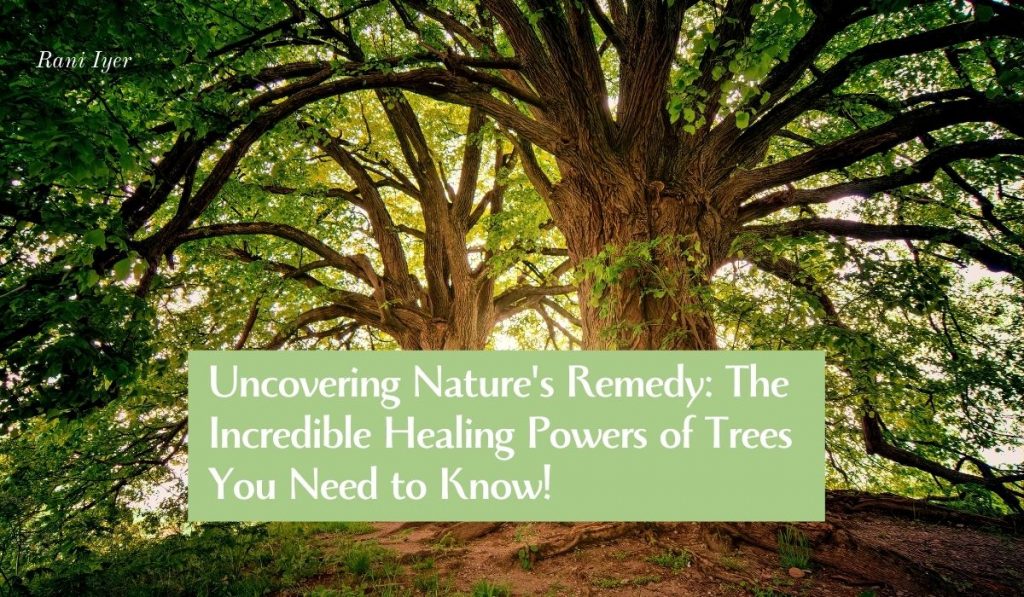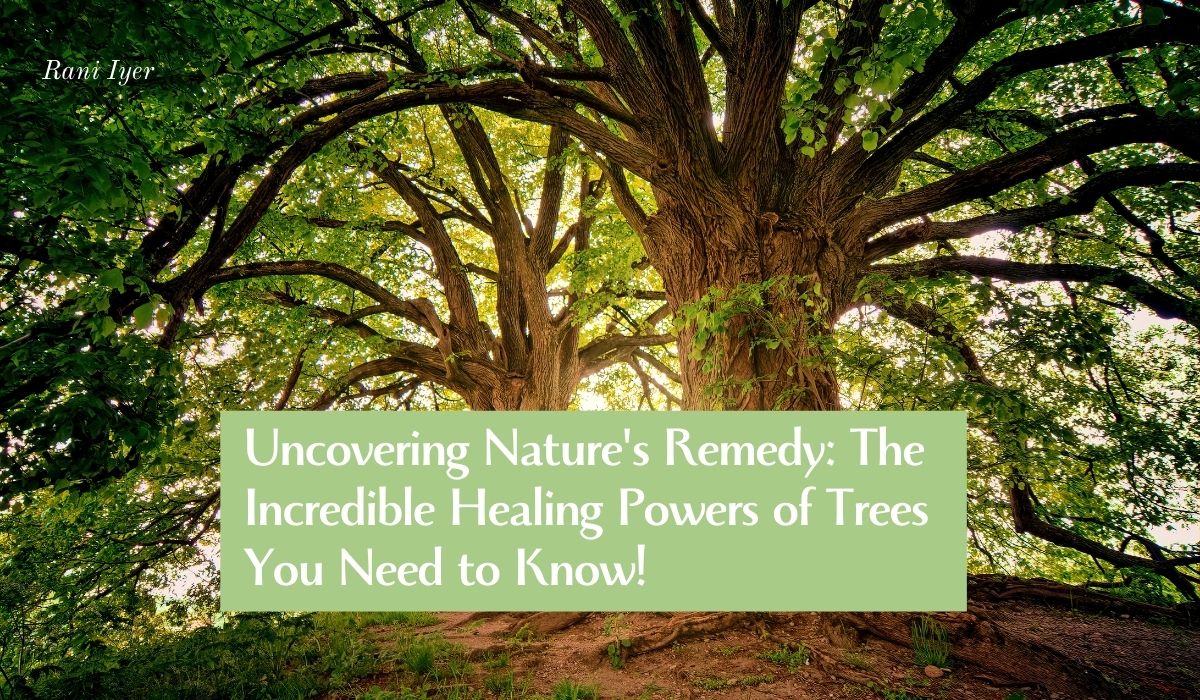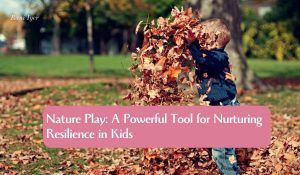
Have you ever paused beneath the canopy of towering trees, feeling a sense of peace wash over you? There’s more to these magnificent giants than meets the eye. Beyond their stunning beauty and vital role in our ecosystem, trees hold incredible healing powers that can enhance your well-being in profound ways. From reducing stress and anxiety to boosting your mood and physical health, nature’s remedy is right in our backyards. In this article, we will explore how the simple act of connecting with trees can unlock a treasure trove of benefits for your mind, body, and spirit. Discover the science behind forest bathing, the therapeutic wonders of tree species, and practical ways to harness their healing energy. Join us as we uncover the secrets of nature’s own remedy and learn how to incorporate these powerful allies into your life for lasting wellness.
The Science Behind Tree Healing Properties
Forests have long been revered for their beauty and serenity, but recent scientific studies have begun to uncover the remarkable healing properties of trees. At the heart of this research is the concept of forest bathing, or “Shinrin-yoku,” a practice that originated in Japan in the 1980s. Forest bathing involves immersing oneself in a forest environment, allowing the sights, sounds, and smells to engage the senses. Studies have shown that this practice can significantly reduce stress hormones, lower blood pressure, and enhance the immune system. Researchers attribute these benefits to the presence of phytoncides, natural oils emitted by trees that have antimicrobial properties and can boost human health.
In addition to phytoncides, trees contribute to human well-being through the release of negative ions, which are abundant in forest environments. Negative ions are molecules that have gained an extra electron, and they are believed to increase the flow of oxygen to the brain, resulting in higher alertness and decreased drowsiness. Research has demonstrated that negative ions can improve mood and overall mental well-being by reducing levels of serotonin, a hormone associated with stress and anxiety. The combination of phytoncides and negative ions creates a powerful natural remedy that promotes physical and mental health.
Moreover, the visual and auditory stimuli provided by forests play a crucial role in the restorative effects of tree-filled environments. The fractal patterns found in the leaves and branches of trees, as well as the calming sounds of rustling leaves and bird songs, have been shown to induce a state of relaxation and reduce mental fatigue. The multisensory experience of being in a forest engages the brain’s parasympathetic nervous system, which is responsible for rest and recovery. This holistic interaction with nature underscores the profound impact that trees can have on our overall well-being.
Benefits of Spending Time in Nature
Spending time in nature, particularly among trees, offers a myriad of benefits that extend beyond the physical. One of the most immediate effects of being in a natural environment is the reduction of stress. The tranquil atmosphere of a forest, combined with the gentle sway of leaves and the scent of pine, can significantly lower cortisol levels, the body’s primary stress hormone. This reduction in stress not only improves mental clarity and focus but also has long-term health benefits by decreasing the risk of chronic diseases linked to high stress levels.
Another significant benefit of spending time in nature is the enhancement of mood and emotional well-being. Natural environments have been shown to elevate mood, reduce feelings of anxiety and depression, and increase overall life satisfaction. The presence of trees and green spaces can provide a sense of peace and tranquility, offering a refuge from the hustle and bustle of urban life. This connection to nature fosters a sense of grounding and mindfulness, allowing individuals to reconnect with themselves and their surroundings.
Furthermore, being in nature encourages physical activity, which is essential for maintaining overall health. Walking, hiking, and other outdoor activities not only provide cardiovascular benefits but also improve muscle strength and flexibility. The natural terrain of forests, with its varied landscapes and obstacles, offers a more engaging and challenging workout compared to indoor environments. This combination of physical exercise and exposure to nature creates a synergistic effect that enhances both physical and mental health.
How Trees Improve Air Quality and Health
Trees play a vital role in improving air quality, which in turn has a direct impact on human health. Through the process of photosynthesis, trees absorb carbon dioxide from the atmosphere and release oxygen, which is essential for human survival. This exchange not only reduces the levels of greenhouse gases but also increases the availability of clean, breathable air. In urban areas, where air pollution is a significant concern, trees act as natural air purifiers, filtering out pollutants such as nitrogen dioxide, sulfur dioxide, and particulate matter.
In addition to carbon sequestration, trees also mitigate air pollution by capturing airborne particles on their leaves and bark. These particles, which include dust, pollen, and smoke, can cause respiratory issues and exacerbate conditions like asthma and bronchitis. By trapping these pollutants, trees help to reduce the incidence of respiratory illnesses and improve overall air quality. This is particularly important in densely populated cities, where the presence of green spaces can make a significant difference in public health.
Moreover, the cooling effect provided by trees contributes to improved air quality and health. Trees provide shade and release water vapor through a process called transpiration, which helps to lower temperatures in urban areas. This reduction in heat not only makes outdoor environments more comfortable but also decreases the formation of ground-level ozone, a harmful air pollutant. By mitigating the urban heat island effect, trees play a crucial role in creating healthier living conditions and enhancing the quality of life for city dwellers.
The Role of Trees in Mental Well-being
The presence of trees and green spaces has a profound impact on mental well-being, offering a natural remedy for many psychological challenges. One of the key ways in which trees benefit mental health is by providing a sense of calm and relaxation. The natural environment of a forest, with its soothing sounds and gentle movements, can lower levels of anxiety and promote a state of mindfulness. This connection to nature helps individuals to feel more grounded and present, reducing the mental clutter that often accompanies modern life.
Additionally, trees have been shown to enhance cognitive function and creativity. Studies have found that spending time in nature can improve attention, memory, and problem-solving skills. This is attributed to the restorative effects of natural environments, which provide a break from the constant stimuli and demands of urban settings. The opportunity to engage with nature allows the brain to recharge, leading to increased mental clarity and innovation. This is particularly beneficial for individuals who work in high-stress or creative fields, as it provides a natural boost to productivity and mental acuity.
Furthermore, the social aspect of green spaces contributes to mental well-being. Parks and forests often serve as communal gathering places, fostering social interactions and a sense of community. These social connections are vital for mental health, as they provide support, reduce feelings of isolation, and enhance overall life satisfaction. The presence of trees and green spaces in urban areas encourages people to come together, creating a supportive environment that promotes emotional well-being and resilience.
Traditional Medicine: Trees as Natural Remedies
Throughout history, various cultures have recognized the medicinal properties of trees and have incorporated them into traditional healing practices. Many indigenous communities have relied on tree-based remedies to treat a wide range of ailments, from digestive issues to respiratory conditions. For example, the bark of the willow tree has been used for centuries as a natural pain reliever, thanks to its active ingredient, salicin, which is a precursor to modern aspirin. This historical use of tree-based remedies highlights the enduring relationship between humans and the natural world.
In Ayurveda, the traditional system of medicine in India, trees play a significant role in promoting health and well-being. Neem, also known as the “village pharmacy,” is a tree that is widely used in Ayurvedic medicine for its antibacterial, antifungal, and anti-inflammatory properties. Neem leaves, bark, and oil are used to treat skin conditions, boost immunity, and support overall health. Similarly, the Indian gooseberry, or Amla, is revered for its high vitamin C content and antioxidant properties, making it a staple in Ayurvedic treatments for improving digestion and enhancing vitality.
Traditional Chinese Medicine (TCM) also utilizes tree-based remedies to balance the body’s energy and promote healing. The ginkgo tree, for instance, is valued in TCM for its ability to improve circulation and enhance cognitive function. Ginkgo biloba supplements are commonly used to support memory and mental clarity, particularly in older adults. The use of tree-derived remedies in TCM underscores the holistic approach to health, where the mind, body, and spirit are interconnected and supported by natural elements.
Notable Trees with Remarkable Healing Qualities
Several tree species are renowned for their exceptional healing qualities, offering a wide range of health benefits. One such tree is the eucalyptus, which is native to Australia and is known for its powerful antiseptic and decongestant properties. Eucalyptus oil, extracted from the leaves of the tree, is commonly used in aromatherapy to relieve respiratory issues such as colds, coughs, and sinusitis. The refreshing scent of eucalyptus also has a calming effect on the mind, making it a popular choice for creating a relaxing atmosphere.
Another notable tree with remarkable healing qualities is the tea tree, indigenous to Australia. Tea tree oil, derived from the leaves of the Melaleuca alternifolia tree, has potent antimicrobial and anti-inflammatory properties. It is widely used to treat skin conditions such as acne, fungal infections, and cuts and scrapes. The versatility of tea tree oil makes it a valuable addition to natural first aid kits, providing an effective remedy for various ailments.
The ginseng tree, particularly the Panax ginseng species, is highly valued in traditional medicine for its adaptogenic properties. Ginseng is believed to enhance physical and mental performance, reduce fatigue, and support the body’s ability to cope with stress. It is commonly used as a tonic to boost energy levels and improve overall vitality. The root of the ginseng tree is often consumed as a tea or supplement, providing a natural way to enhance well-being and resilience.
How to Incorporate Tree Healing into Your Life
Incorporating the healing powers of trees into your daily life can be both simple and rewarding. One of the easiest ways to connect with trees is by spending time in nature. Whether it’s a walk in the park, a hike in the forest, or simply sitting under a tree in your backyard, immersing yourself in a natural environment can have profound effects on your well-being. Make it a habit to spend at least 20-30 minutes a day outdoors, allowing yourself to fully engage with the sights, sounds, and smells of the natural world.
Another way to harness the healing energy of trees is through the use of essential oils and herbal remedies. Essential oils such as eucalyptus, tea tree, and cedarwood can be diffused in your home to create a calming atmosphere and support respiratory health. Herbal teas made from tree leaves, such as ginkgo biloba or neem, can provide additional health benefits and promote relaxation. These natural remedies offer a convenient way to incorporate the therapeutic properties of trees into your daily routine.
Engaging in practices such as forest bathing or meditation under a tree can also enhance your connection to nature and promote mental well-being. Forest bathing involves slow, mindful walks through the forest, allowing you to fully immerse yourself in the environment and experience its healing effects. Similarly, meditating under a tree can provide a sense of grounding and tranquility, helping to calm the mind and reduce stress. These practices encourage a deeper connection to the natural world and can be incorporated into your self-care routine.
Community Initiatives: Trees and Public Health
Community initiatives that focus on planting and preserving trees can have a significant impact on public health and well-being. Urban forestry programs, which aim to increase the number of trees in cities and towns, play a crucial role in improving air quality, reducing heat, and enhancing the overall quality of life for residents. These programs often involve community engagement, encouraging residents to participate in tree planting and maintenance activities. By fostering a sense of ownership and responsibility, these initiatives promote a healthier and more sustainable environment.
Green spaces and parks, which are often the result of community-driven efforts, provide essential recreational and social opportunities for residents. These areas offer a place for physical activity, relaxation, and social interaction, all of which contribute to improved mental and physical health. Community gardens, which incorporate trees and other plants, also provide a source of fresh produce and promote healthy eating habits. These spaces serve as vital resources for urban communities, offering a natural refuge from the stresses of daily life.
Educational programs that highlight the benefits of trees and nature can also play a pivotal role in promoting public health. Schools, community centers, and local organizations can organize workshops, nature walks, and other activities that educate residents about the importance of trees and how to care for them. These programs not only raise awareness about environmental conservation but also empower individuals to take an active role in improving their health and well-being. By fostering a connection to nature, these initiatives help to create healthier, more resilient communities.
Embracing Trees as Natural Healers
In conclusion, the incredible healing powers of trees are a testament to the profound connection between humans and the natural world. From reducing stress and improving mental well-being to enhancing physical health and promoting environmental sustainability, trees offer a wealth of benefits that can enhance our lives in countless ways. By understanding the science behind tree healing properties and incorporating these natural remedies into our daily routines, we can unlock a treasure trove of wellness and vitality.
Embracing trees as natural healers involves both individual and collective efforts. On a personal level, spending time in nature, using tree-based remedies, and engaging in practices such as forest bathing can significantly improve our well-being. On a community level, supporting urban forestry programs, creating green spaces, and participating in educational initiatives can foster a healthier and more sustainable environment for all. By working together, we can ensure that the healing powers of trees continue to benefit future generations.
Ultimately, the journey to well-being is deeply intertwined with our relationship to nature. As we uncover the secrets of nature’s remedy, we are reminded of the importance of preserving and nurturing the natural world. By embracing the incredible healing powers of trees, we can cultivate a sense of harmony and balance in our lives, paving the way for lasting wellness and vitality. So, the next time you find yourself beneath the canopy of towering trees, take a moment to pause and appreciate the natural remedy that surrounds you. The benefits are waiting to be discovered.



